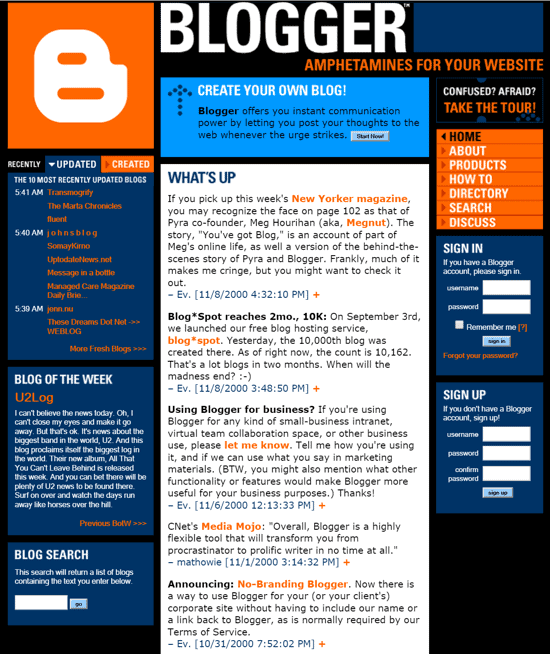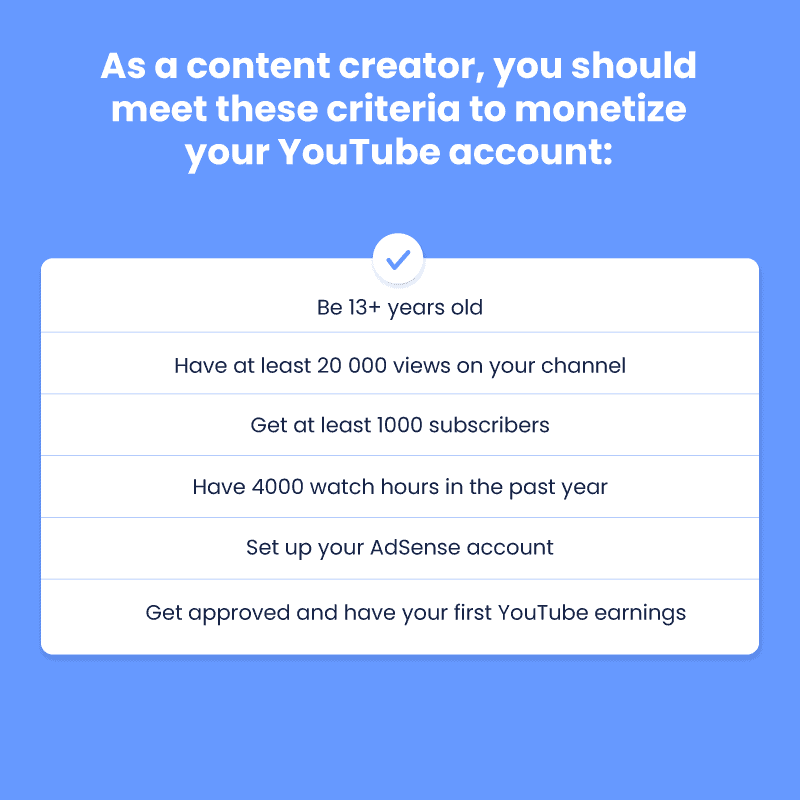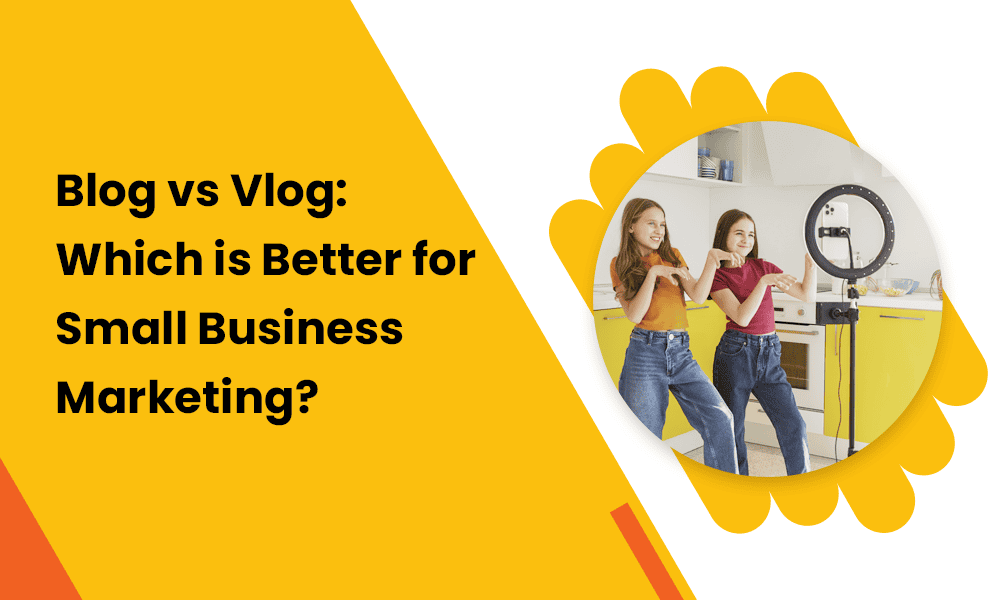If you’re a small business owner, you know that content creation can be a great, organic way to build an audience and drive sales. The problem is there are dozens of platforms to choose from, each with its pros and cons. Case in point: blog vs vlog. They are both low-cost options that are relatively easy to start with. However, depending on the niche, they can also be fiercely competitive.
Plus, you also have to consider the time required to create content and assess if the monetization potential is worth it. In this article, we will dive deep into the pros and cons of blogging vs vlogging and help you identify which is better. We’ll discuss:
- The differences between blog and vlog
- How to start a blog or vlog?
- Which is better: blog vs vlog?
- Let’s get started.
Table of Contents
Vlog vs Blog: Definitions
Let’s first understand what a blog and vlog is.
What is a blog?
A blog is short for weblog. It’s a website that mainly uses text as a medium to share information, educate readers, and build brand awareness. Businesses have used blogs for marketing since the launch of Blogger in 1999. WordPress arrived in 2003 and it became easier for people without technical skills to start and run their blogs.
In 2008, Google launched AdSense giving bloggers the ability to monetize their content for the first time. As of today, there are over 600 million blogs active on the internet. Blogs can be a great way to try out different niches and settle on the best one that fits your interests and personality.

What is a vlog?
A vlog is short for video blog. As the name suggests, it uses video to communicate your message. Vlogs are generally used to share personal stories, interests, and skills. However, there are millions of niche vlogs that focus on specific topics such as travel, fashion and beauty, fitness, and health.
Vlogging has taken off in a big way, thanks to social media and smartphones. You can use vlogging to build a personal brand or drive traffic to your business.
Blog vs Vlog: What Are The Key Differences?
The fundamental difference between a blog vs vlog is the format. However, you also need to consider how it might fit into your day-to-day schedule, the skills and equipment you’ll need, and how soon you might see a return on investment. Let’s explore this in more detail:
1. How much time does it take?
You probably guessed this one. Blogging is the less time-consuming of the two. If you have done your research and know your target audience well, you can churn out blogs on relevant topics within hours. Editing and formatting the text only takes a few minutes, slightly longer if you’re adding images, SEO keywords, and links.
You only need to look at engagement data once or twice a month to identify popular topics and develop them further. You can leverage tools like Google Analytics, SEMRush, or Ubersuggest for this.
On the other hand, writing scripts, and shooting and editing videos takes considerably more time. You may need multiple takes if the lighting is bad or to add effects during editing. Things get a lot easier with the right video editing templates and macros, though. Making thumbnails, adding SEO descriptions and branding can take hours to several days. Learning SEO is critical to make sure your videos are discoverable on social media platforms.
2. What equipment do you need for blog vs vlog?
Although you could shoot videos on your smartphone, edit them on the fly, and upload them instantly, the quality of your content won’t be the same. At the very minimum, you’ll need a professional camera, mic, and editing software. Depending on whether you’ll be shooting indoors or outdoors, you’ll also need a tripod, and light stands.
So, you can expect higher upfront costs with vlogging. Now, I’m not suggesting you buy all of this in one go. Start with the basic stuff and then upgrade to better quality products as your vlog start to grow.
To start a blog, you need no equipment other than a computer and an internet connection.
3. What platforms are the best for blogging vs vlogging?
There are multiple blogging platforms you can choose from. WordPress, Medium, Tumblr, and Squarespace are some of the most popular ones. Make sure you get a paid subscription though. A paid blogging account gives you access to the full range of features, templates, customization, and reporting options. Paid plans also come with custom domain names that align well with your branding.
For vlogging, YouTube remains the best platform by far, with over 2 million monthly active users. However, TikTok and Instagram are not too far behind. They are very popular with younger audiences. Invest in a business account so that you can leverage their targeting and advertising tools to create effective campaigns.
How Netflix Marketing Wins Audience Every Time
Blog vs Vlog Monetization Options
If you’ve been getting steady traffic and engagement for about 6 months, it’s time to monetize! Of course, you have to meet the monetization rules for each platform.
For example, YouTube requires that you have 1000 subscribers and 4000 hours of watch time in the past 12 months. Your content must meet the community guidelines.
Here are some ways to monetize your content.
1. Blogs
If you have good traffic, consider applying for a Google AdSense account and running ads relevant to your blog content. You can earn based on the number of views, clicks, and conversions.
Affiliate marketing is another great option. You can promote products from other brands on your blog and add affiliate links. Every time somebody makes a purchase using the link, you get a commission.
Once you have built up enough brand authority, you can create your products too. For example, you can turn the most popular posts into an e-book or even an online course.
You can also add a section for premium content like reports, case studies, and exclusive previews that readers pay to access. The key is to promote your paid products via dedicated landing pages and social media.

2. Vlogs
You can sign up for their partner program if you meet YouTube’s monetization requirements. This lets you place a variety of ads within your videos, such as before, during, and/or after the video has played.
You can offer paid memberships to subscribers and earn a portion of the revenue.
You can also collaborate with brands and promote their products via sponsored videos.
16 Top Business Movies Every Entrepreneur Must Watch
Starting your Blog or Vlog
If you are considering starting your blog, here are a few key steps to consider.
1. Pick your niche wisely
A niche is the topic you want to write about. Remember, it doesn’t have to be about your industry or product. Look to align with the audience’s interests and your brand image. This can create positive associations and build trust.
Red Bull is a great example of this. Instead of blogging about energy drinks, they prefer to focus on adventure sports and lifestyle.
2. Research, research, research
Leverage tools like Google Keyword Planner to find popular topics and look for new angles or related ideas. Next, analyze the topics your favorite bloggers create and look for gaps you can capitalize on. If you have an email newsletter, run surveys or feedback forms to validate your blog idea.
Not all of them will work, though. Keep a running list of ideas on Dropbox or Google Drive so you can capture them as they occur.
3. Set up your blog
If you’ve decided what blog platform to use, you must figure out hosting and domain name. Bluehost, Hostinger, and Siteground are all good hosting options. Choose one that can preferably take care of both. Make sure your domain name is interesting and memorable. Next, it’s time to update your blog design and layout to provide a smooth reading experience.
Remember to choose a responsive theme and layout so your blog looks as attractive on a desktop as on a smartphone.
4. Create relevant content
Keyword research and competitor analysis are certainly important. However, to create relevant content, you’ve got to start with the customer. Define the target audience’s pain points, and you’ll have no problems finding high-traffic topics to write about and create value for them.
Don’t be afraid to ask customers what they want to read more about. You can also use surveys, feedback forms, and emails for this purpose. This will help you be more relevant to your audience and position you as a thought leader.
5. Promote your blog
You should invest time in promoting your blog on social media – search for topics related to your blog on Quora, Facebook or Twitter and hit follow. Engage in conversations and give thoughtful answers so that members think of you as a go-to resource for a certain problem they might have.
This will generate traffic to your blog and increase your credibility. Networking with other bloggers in your niche can also help you reach new audiences organically.
For example, guest posts, podcast appearances, etc. It also makes sense to invest in paid ads if you’re targeting a niche audience.
The initial steps to starting a vlog are no different than blogging. You do need to find an enjoyable niche and plan your content. The key is to:
5. Focus on quality
As an expert in your field, you probably have a lot to say to your audience. However, it’s important how you say it – the overall experience. That means professional sound and image quality. Invest in a quality camera, recording equipment, post-production, and SEO. This will help you rank and attract more engagement.
6. Leverage reporting data
On platforms like YouTube, you can measure engagement trends over time and get a better understanding of your audience’s likes and dislikes. This can help you fix problems. For example, let’s say your audience isn’t watching to the end. Metrics like average view time can tell you why.
These insights can help you create better content. For example, you can optimize length, provide an overview of the topic right at the start, and offer incentives to increase engagement. These include giveaways, promo codes, etc.
20 Smart Email Marketing Tips Bloggers Should Know
Blog vs Vlog: Which is Better?
The answer to this question depends on several factors. Let’s explore them in detail:
1. Your product or niche
Let’s say you have a software or financial product. To market it to your audience, you’d need to provide in-depth technical information. Blogs can be perfect for the job. They let you provide plenty of context around data and condense it in tables and flowcharts. The reader does not need to take notes, as in the case of a video presentation.
You can highlight key points for readers to focus on and provide additional reference links to brochures or landing pages. On the other hand, a fitness or electronic product is more of a visual product that needs step-by-step visual demonstration, and a vlog is usually the best option.
2. Audience preferences
According to a recent survey, 98% of millennials and Gen Z audiences watch video content on their smartphones. This is a trend that here’s to stay. On the other hand, an older audience may want to read facts and figures presented logically and reach their own conclusions. The key is to segment your audience and leverage surveys, or feedback forms to gauge their preferences.
3. Personal connection
What are your strengths? If yes, vlogging can help you connect better with your audience and on a more personal level. It allows you to leverage your personality and charisma to engage and grow your community.
Key Things to Remember When Choosing Between Blog vs Vlog
- If you have good SEO knowledge and are targeting a niche topic, blogging can be a great option.
- If you aim to build an audience from scratch, vlogging can help you get there relatively faster.
- Vlogs can also be a great choice if you want to repurpose your content into other formats like short videos, etc. You can create snippets of the key topics and share them via social media.
- Don’t try to do both at the same time, especially if you’re just getting started. It can lead to burnout and detract from the day-to-day running of your business. It’s a different matter if you can hire a dedicated video content creator and/or blogger to do it for you.
Conclusion
Content creation is a long-term game; you need real-time tracking to identify your most successful marketing channels. EngageBay provides link tracking across your websites, social media, emails, and other channels to give you a complete picture of engagement and conversion, helping you save time and money.
It can automatically capture and segment lead data for personalized follow-ups. This means you are more likely to convert them into customers over time. Check out our free CRM or talk to our team today!
FAQ
1. Do blogs or vlogs make more money?
Income from blogs and vlogs can vary significantly. It depends on the niche you choose, the platform you’re on, your content quality, and whether or not you have an existing audience. Generally, blogs take longer to monetize than vlogs.
2. Should I start a blog or YouTube channel first?
It all depends on your strengths and target audience. A YouTube channel can be a great option if you’re comfortable on camera and have the skills to produce, edit, and distribute video content. Remember, you can repurpose video transcripts into blog posts and vice versa.
3. How much money per 1,000 views on vlog?
It depends on the platform. On YouTube, you get paid $0.01 to $0.03 per view, from $10 to $30 per 1,000 views.
